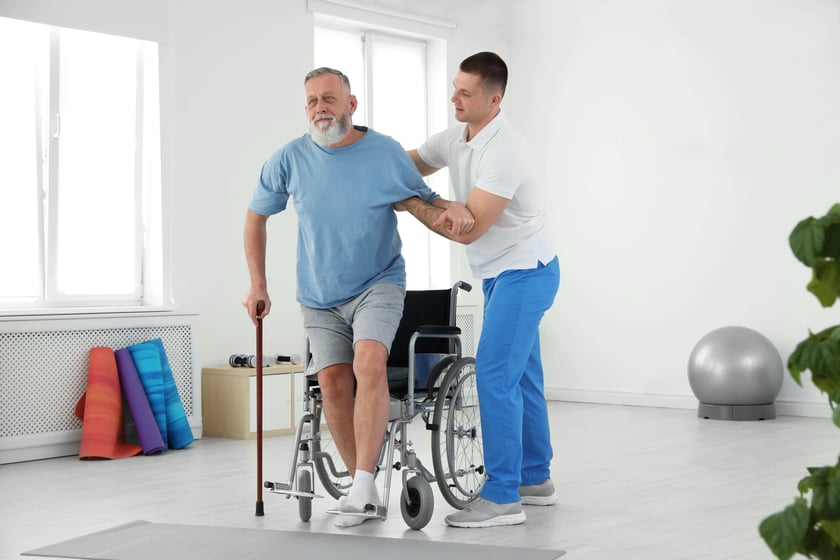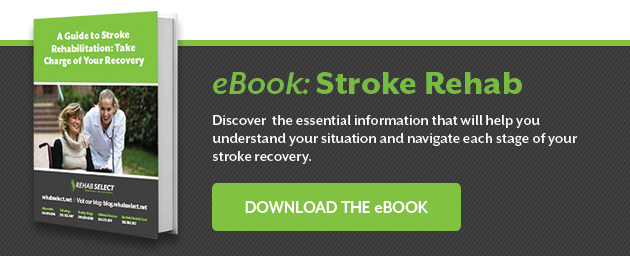
After a stroke, one of the most important ways to encourage recovery is to begin a rehabilitation program right away. The overarching goal of stroke rehabilitation is to stabilize your condition, help you gain optimal function, and promote the best quality of life.
Download the Stroke Rehab eBook
Stroke rehabilitation techniques might involve relearning skills or making modifications so you can achieve a sense of normalcy again.
At inpatient rehab facilities like Rehab Select, a group of specialists incorporate best-in-class stroke rehabilitation methods to help you achieve that goal. This post-stroke rehab team usually includes a physical therapist, occupational therapist, speech-language pathologist, social worker, neurologist, and others depending on your needs. Each professional introduces new stroke rehabilitation techniques to help build momentum toward your recovery. We’ll discuss some of the most common approaches here.
1. Speech-Language Therapy
What is it?
Speech and language pathologists help patients recover their ability to communicate and swallow after a stroke. They also help improve patients' skills related to reading and writing. In speech and language therapy, you practice stroke rehabilitation techniques to help you relearn or find alternative methods for communication.
Techniques used:
Some of the stroke rehabilitation techniques used to improve swallowing include body positioning, tongue strengthening exercises, and dietary modifications. Your therapist can teach you how to prepare food, engage your swallowing muscles, and sit properly to make swallowing easier.
If you experience problems communicating, such as constructing sentences, comprehending, or remembering words, your therapist uses a variety of approaches to improve your skills. For example, they can teach you breathing and cadence exercises to improve sentence formation and speech coordination. Word meaning and repetition practice help you build new neural pathways between words and their meanings.
Benefits:
Learning how to speak again is just like learning a new language. With practice, word associations become stronger, and your conversation and comprehension skills improve. Those communication skills are vital for relationships, work, and everyday activities.
Swallowing skills help you avoid the choking issues, malnourishment concerns, and embarrassment associated with not being able to swallow. The emotional and interpersonal toll can lead to isolation and depression, so therapy is vital for both your physical and mental wellbeing.
2. Physical Therapy
What is it?
An individualized physical therapy program helps stroke patients regain their physical function or compensate for physical deficits after a stroke. Strokes often cause temporary or permanent paralysis on one side of the body, and the purpose of physical therapy is to improve mobility and movement where there’s impairment.
Techniques Used:
Physical therapy for stroke often involves strength and mobility training and range-of-motion exercises. A physical therapist can help you improve the function of impaired limbs with motor relearning techniques and ambulation. They may also incorporate e-stimulation and other therapies into their treatment plans.
Benefits:
Physical therapy helps keep affected muscles and nerves stimulated even before you’re able to use them again. Once you’re able to move about, physical therapy helps you retrain your brain and regain control of your body. Balance and coordination help you avoid falls while mobility exercises and assistive devices allow you to perform your daily activities again.
3. Occupational Therapy
What is it?
Occupational therapy focuses on restoring your ability to perform routine daily activities, such as cooking, driving, doing household chores, and grooming. An occupational therapist also helps you overcome physical limitations, adapt your living spaces, and avoid safety concerns.
Techniques used:
Perceptual training is one of several stroke rehabilitation methods often used in occupational therapy to help patients with sensory and perceptual deficits. This type of training helps stroke patients overcome visual impairments, perception problems, or one-sided paralysis.
Repetitive activities are another method used to help stroke survivors relearn how to perform necessary tasks. For example, your therapist may break up tasks into single activities (i.e., cracking, whisking, then folding eggs) and have you repeat each activity. Then, you practice performing the activities in sequence until you master the skill (i.e., cooking scrambled eggs).
Benefits:
The main goal of occupational therapy is to restore your independence and improve your quality of life after a stroke. The stroke therapy equips you with the proper tools to make a safe, effective return home.
4. Neurological Therapy
What is it?
Neurological therapies help improve cognitive and motor impairments caused by brain and nerve damage from a stroke. These therapies can improve recovery and reduce symptoms.
Techniques used:
Magnetic brain stimulation is a new, promising neurological treatment for stroke patients. The noninvasive stroke therapy stimulates nerve cells to encourage neuroplasticity and brain healing. Brain exercises for stroke recovery may also be included in your treatment plan. They include brain teasers, puzzles, music, and creative projects.
Benefits:
The neuroplasticity of our brains allows them to change, adapt, and learn new patterns at any age. Magnetic brain stimulation appears to help patients walk and move better after a stroke while brain exercises help sharpen your cognitive function.
5. Mirror Therapy
What is it?
Mirror therapy is a technique for one-sided paralysis or weakness. Your therapist has you move your unaffected limb and watch it in a mirror. Your brain processes the movement in the mirror as though it’s happening to the affected limb. Eventually, you may notice improvements in your control of the affected side.
Techniques used:
During mirror therapy, most people do small hand, arm, and fine motor skill exercises with the mirror. Not only does this improve strength and coordination in the unaffected limb, but it also enhances motor control on the affected side.
Benefits:
During mirror therapy, the brain perceives the affected side moving in the mirror and starts to rewire itself as though it truly is moving. With time, this process may improve strength and mobility on your weak or paralyzed side.
6. Recreational Therapy
What is it?
Like occupational therapy, recreational therapy helps you return to the activities you enjoy or learn new ones, specifically recreational activities. Your occupational therapists help you spend your leisure time doing things that improve your mood or provide health benefits.
Techniques used:
Recreational therapists use many of the stroke rehabilitation techniques used during physical, speech, and occupational therapy to help you successfully participate in leisure time activities. You use the communication skills from speech therapy to interact with others and the physical abilities gained from physical and occupational therapies to perform activities.
For example, if you enjoy playing cards with your friends, your recreational therapist can help you rebuild the skills to shuffle, deal, play, and communicate.
Benefits:
Returning to your hobbies is a gratifying feeling. Recreational activities give meaning and purpose to your time. They help you enjoy your days. What you do in your leisure time can also help you recover faster and improve your feelings of social connection.
Learn More About Post-Stroke Rehabilitation in Alabama
Stroke specialists across Rehab Select's five Alabama locations use the most up-to-date, research-backed stroke rehabilitation methods, including the ones above, to improve recovery after a stroke. If you’re looking for a trusted inpatient or outpatient stroke rehabilitation center, contact Rehab Select online or call 844-734-2200 today.




